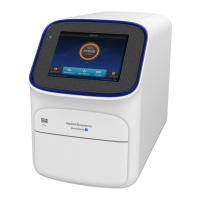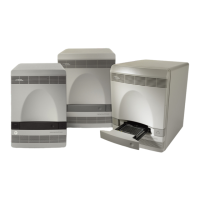Correct trim Incorrect trim
9.
Repeat step 8 to seal the remaining array cards.
IMPORTANT! If an array card is sealed improperly
, it can leak and contaminate the
sample block and/or it can cause the associated calibration or RNase P test to fail.
IMPORTANT! As you seal the remaining lled array cards, store them in a dark place.
Do not expose the array cards to light until you are ready to use them. The dyes in the
array cards are photosensitive. Prolonged exposure to light can diminish the
uorescence of the dye.
ROI calibration
A region of interest (ROI) calibration maps the positions of the w
ells on the sample
block of the instrument. The software uses the ROI calibration data to associate
increases in uorescence during a run with the wells on the plate or array card. The
instrument uses a set of optical lters to distinguish the uorescence emissions
gathered during runs. The software generates a calibration image for each lter to
account for minor dierences in the optical path.
Perform the ROI calibration once every 6 months.
IMPORTANT! For the 96-w
ell plate block and the 384-well plate block, after every
ROI calibration, you must perform (in order): a background calibration, uniformity
calibration, and a dye calibration.
For the TaqMan
®
Array Card block, after every ROI calibration, you must perform (in
order): a background calibration, uniformity calibration, dye calibration, and a
normalization calibration.
When to perform
the c
alibration
Chapter 2 Calibr
ate the instrument
ROI calibration
2
QuantStudio
™
6 and 7 Flex Real-Time PCR Systems v1.6 Maintenance and Administration Guide
41
